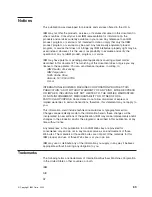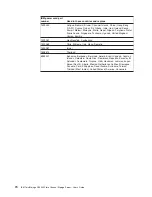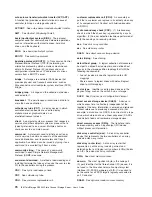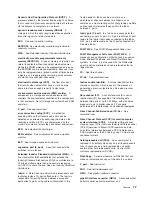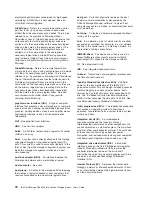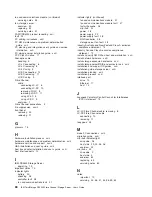
Internet
Protocol
(IP)
address.
The
unique
32-bit
address
that
specifies
the
location
of
each
device
or
workstation
on
the
Internet.
For
example,
9.67.97.103
is
an
IP
address.
interrupt
request
(IRQ).
A
type
of
input
found
on
many
processors
that
causes
the
processor
to
suspend
normal
processing
temporarily
and
start
running
an
interrupt
handler
routine.
Some
processors
have
several
interrupt
request
inputs
that
allow
different
priority
interrupts.
IP.
See
Internet
Protocol
.
IPL.
See
initial
program
load
.
IRQ.
See
interrupt
request
.
ISA.
See
Industry
Standard
Architecture
.
Java
Runtime
Environment
(JRE).
A
subset
of
the
Java
Development
Kit
(JDK)
for
end
users
and
developers
who
want
to
redistribute
the
Java
Runtime
Environment
(JRE).
The
JRE
consists
of
the
Java
virtual
machine,
the
Java
Core
Classes,
and
supporting
files.
JRE.
See
Java
Runtime
Environment
.
label.
A
discovered
or
user
entered
property
value
that
is
displayed
underneath
each
device
in
the
Physical
and
Data
Path
maps.
LAN.
See
local
area
network
.
LBA.
See
logical
block
address
.
local
area
network
(LAN).
A
computer
network
located
on
a
user’s
premises
within
a
limited
geographic
area.
logical
block
address
(LBA).
The
address
of
a
logical
block.
Logical
block
addresses
are
typically
used
in
hosts’
I/O
commands.
The
SCSI
disk
command
protocol,
for
example,
uses
logical
block
addresses.
logical
partition
(LPAR).
(1)
A
subset
of
a
single
system
that
contains
resources
(processors,
memory,
and
input/output
devices).
A
logical
partition
operates
as
an
independent
system.
If
hardware
requirements
are
met,
multiple
logical
partitions
can
exist
within
a
system.
(2)
A
fixed-size
portion
of
a
logical
volume.
A
logical
partition
is
the
same
size
as
the
physical
partitions
in
its
volume
group.
Unless
the
logical
volume
of
which
it
is
a
part
is
mirrored,
each
logical
partition
corresponds
to,
and
its
contents
are
stored
on,
a
single
physical
partition.
(3)
One
to
three
physical
partitions
(copies).
The
number
of
logical
partitions
within
a
logical
volume
is
variable.
logical
unit
number
(LUN).
An
identifier
used
on
a
small
computer
system
interface
(SCSI)
bus
to
distinguish
among
up
to
eight
devices
(logical
units)
with
the
same
SCSI
ID.
loop
address.
The
unique
ID
of
a
node
in
fibre-channel
loop
topology
sometimes
referred
to
as
a
loop
ID.
loop
group.
A
collection
of
storage
area
network
(SAN)
devices
that
are
interconnected
serially
in
a
single
loop
circuit.
loop
port.
A
node
port
(N_port)
or
fabric
port
(F_port)
that
supports
arbitrated
loop
functions
associated
with
an
arbitrated
loop
topology.
LPAR.
See
logical
partition
.
LUN.
See
logical
unit
number
.
MAC.
See
medium
access
control
.
management
information
base
(MIB).
The
information
that
is
on
an
agent.
It
is
an
abstraction
of
configuration
and
status
information.
man
pages.
In
UNIX-based
operating
systems,
online
documentation
for
operating
system
commands,
subroutines,
system
calls,
file
formats,
special
files,
stand-alone
utilities,
and
miscellaneous
facilities.
Invoked
by
the
man
command.
MCA.
See
micro
channel
architecture
.
media
scan.
A
media
scan
is
a
background
process
that
runs
on
all
logical
drives
in
the
storage
subsystem
for
which
it
has
been
enabled,
providing
error
detection
on
the
drive
media.
The
media
scan
process
scans
all
logical
drive
data
to
verify
that
it
can
be
accessed,
and
optionally
scans
the
logical
drive
data
also.
medium
access
control
(MAC).
In
local
area
networks
(LANs),
the
sublayer
of
the
data
link
control
layer
that
supports
medium-dependent
functions
and
uses
the
services
of
the
physical
layer
to
provide
services
to
the
logical
link
control
sublayer.
The
MAC
sublayer
includes
the
method
of
determining
when
a
device
has
access
to
the
transmission
medium.
Metro
Mirroring.
This
term
is
used
to
refer
to
a
remote
logical
drive
mirror
pair
which
is
set
up
with
synchronous
write
mode.
See
also
remote
mirroring
,
Global
Mirroring
.
MIB.
See
management
information
base
.
micro
channel
architecture
(MCA).
Hardware
that
is
used
for
PS/2
Model
50
computers
and
above
to
provide
better
growth
potential
and
performance
characteristics
when
compared
with
the
original
personal
computer
design.
Microsoft
Cluster
Server
(MSCS).
MSCS,
a
feature
of
Windows
NT
Server
(Enterprise
Edition),
supports
the
connection
of
two
servers
into
a
cluster
for
higher
availability
and
easier
manageability.
MSCS
can
automatically
detect
and
recover
from
server
or
Glossary
79
Содержание TotalStorage DS4500
Страница 1: ...IBM TotalStorage DS4500 Fibre Channel Storage Server User s Guide GC26 7726 00...
Страница 2: ......
Страница 3: ...IBM TotalStorage DS4500 Fibre Channel Storage Server User s Guide GC26 7726 00...
Страница 7: ...Glossary 75 75 Index 85 Contents v...
Страница 8: ...vi IBM TotalStorage DS4500 Fibre Channel Storage Server User s Guide...
Страница 10: ...viii IBM TotalStorage DS4500 Fibre Channel Storage Server User s Guide...
Страница 12: ...x IBM TotalStorage DS4500 Fibre Channel Storage Server User s Guide...
Страница 18: ...xvi IBM TotalStorage DS4500 Fibre Channel Storage Server User s Guide...
Страница 72: ...42 IBM TotalStorage DS4500 Fibre Channel Storage Server User s Guide...
Страница 96: ...66 IBM TotalStorage DS4500 Fibre Channel Storage Server User s Guide...
Страница 114: ...84 IBM TotalStorage DS4500 Fibre Channel Storage Server User s Guide...
Страница 121: ......
Страница 122: ...Part Number 25R0401 Printed in USA GC26 7726 00 1P P N 25R0401...





